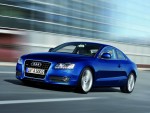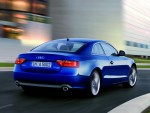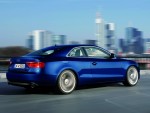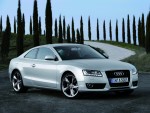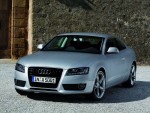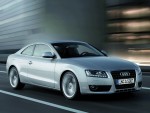2008 Audi A5
2008 Audi A5 Pictures & Specifications
Home »
Audi
Pictures & Wallpapers
Technical Specifications
Make: Audi
Model: A5 3.0 TDI Quattro
Engine: 3.0 litre V6 diesel
Aspiration: Turbocharged
Maximum Power: 176 kW (240 hp)
Maximum Torque: 500 Nm (369 lb-ft)
Transmission: Continuously variable transmission (CVT)
Drivetrain: All-wheel drive
The Audi A5 Engines
Audi Press Release
16 April 2007
Sportiness and effortless driving pleasure
A coupe with a distinctly sporty character requires powerful and highly efficient engines. For the Audi A5, power is provided by innovative technology across the board. All engines supplied for the new model series feature direct fuel injection, for which the petrol engines employ the FSI concept and the diesels are equipped with common rail TDI.
This gives all engines a thrilling free-revving character, allowing them to effortlessly unwind their generous torque with optimum energy efficiency. The refined TDI engines with their outstanding sporting talents suit the A5 just as well as the petrol units. Which type to go for depends entirely on the driver’s personal preference. All of the engines also impressively demonstrate that efficiency and driving pleasure can superbly complement each other.
The innovative power of direct injection
High peak output, muscular pulling power at all engine speeds, refined running and this combined with low fuel consumption – these strengths typify the current Audi engine range. Here the new family of V-engines is particularly impressive. They have a 90-degree cylinder angle with a cylinder spacing of 90 mm, and the engine ancillaries are powered from a space-saving, high-durability chain drive on the rear side of the engine. And however different their combustion processes and designs, they all share the innovative power of direct injection.
In engine technology, Audi engineering has always shown “Vorsprung durch Technik”: in 1989, for instance, Audi launched the TDI engines, which have gone from strength to strength since. Throughout these eighteen years Audi has been the leader in diesel technology. The petrol direct injection system FSI, another piece of pioneering engineering from Audi, was a celebrated success right from its introduction. In June 2001, the Audi R8 racing car won the Le Mans 24 Hours, proving the speed and reliability of FSI power. Over the following years, 64 more wins out of 80 starts followed. FSI technology is also the perfect example of a parallel development for motor racing and production vehicles: on the roads FSI engines have become another exceptional success story.
FSI – The high-tech engine with variable valve lift
The top-of-the-range petrol engine in the Audi A5 is a new 3.2-litre V6. It is, of course, equipped with FSI direct injection, but also features another masterpiece from the engine developers in Ingolstadt and Neckarsulm: the innovative Audi valvelift system. This innovation varies the valve lift between two levels. The effect is an appreciable increase in engine efficiency. The driver benefits from more harmonious power build-up and improved engine dynamics, while enjoying a marked reduction in fuel consumption.
At the wheel of an Audi A5 3.2 FSI, you have a whole 195 kW (265 bhp) of power output at your disposal and a superb torque of 330 Nm in a broad rev band of 3,000 to 5,000 rpm, ensuring blistering acceleration at all times. The 3.2 FSI quattro with 6-speed manual gearbox sprints from 0 to 100 km/h within 6.1 seconds. Its top speed is limited to 250 km/h. This thrilling performance potential contrasts with the 3.2 FSI multitronic’s very moderate fuel consumption of only 8.7 litres per 100 kilometres.
The fact that this engine successfully marries energetic power development and efficient use of fuel owes much to its direct fuel injection, which makes possible the extremely high compression ratio of 12.5:1, thus leading to highly efficient combustion. The second major factor is the Audi valvelift system. To briefly explain the background: a petrol engine needs the throttle valve to regulate the flow of intake air. At part throttle, however, the engine draws air against the resistance caused by the throttle valve. That results in a considerable loss in operating efficiency.
The engine can breathe freely
With the Audi valvelift system the throttle valve can remain open over a wide scope of engine operating states – the engine can breathe more freely and there are no throttle losses. Instead, the flow of intake air is controlled via the valve stroke: at part throttle, the intake valve opens less widely and less combustion air flows into the cylinder. The valvelift system in itself considerably reduces fuel consumption, with potential savings of seven percent.
Audi’s comparatively simple design of the variable valve stroke is truly revolutionary. It requires no additional components, but is located directly on the intake camshaft. It has sliding cam units which support two cam contours, side by side, for small and large valve travel. Electromechanical actuators move the cam units in accordance with the engine power demand and adjust the valve stroke between two and eleven millimetres.
The all-new high-tech four-cylinder unit in the Audi A5 also does full justice to Audi’s reputation for leading engine technology. The 1.8 TFSI, delivering 125 kW (170 bhp), will be available from autumn 2007. It combines turbocharger technology with petrol direct injection and provides a burst of acceleration and pulling power unrivalled in its class from virtually every rev band.
TFSI – a new benchmark for its class
The injection pressure, increased to 150 bar, and the new six-hole injectors guarantee highly homogeneous mixture preparation and also extremely efficient combustion. The optimised turbocharger and a new engine management system provide a spontaneous engine response and a very smooth torque build-up. The entirely new basic engine is designed with an eye to especially high refinement and low vibrations.
The 1.8 TFSI consequently redefines the standard in its class for output, torque and also acoustic behaviour.
Just as it did with its TDI engines, Audi has accomplished a pioneering feat of engineering with its turbocharged direct-injection petrol units, taking spark-ignition engines to a new dimension in fuel consumption and driveability. Like the V6 FSI, the 1.8 TFSI is an extremely efficient engine that delivers low fuel consumption and consequently reduced CO2 emissions, thanks to a wide range of technical innovations.
TDI – the best diesel engine is now even better
The V6 TDI units from Audi also set the standard in their segment. Their copious torque and outstanding economy accompanied by superb refinement mean that they score highly on all counts. In addition to all this, they offer eco-friendly performance that is hard to beat. Moreover the TDI engines fitted in the Audi A5 are – as in all Audi models – equipped with diesel particulate filters as standard and already comply with the Euro 5 standard which will apply in future.
The sporty top-of-the-range TDI for the coupe is the thoroughly revised 3.0-litre engine. It now delivers a power output of 176 kW (240 bhp) and its maximum torque is an immense 500 Nm. But that is not all: with its supreme 0 to 100 km/h acceleration time of 5.9 seconds and a maximum speed of 250 km/h, the Audi A5 3.0 TDI quattro stands out as a high-performance coupe of the first order. It is also one of the cleanest and most economical, consuming only 7.2 litres over 100 kilometres, with exceptionally low emissions.
An advanced sports engine with fascinating economy
The way the 3.0 TDI goes to work is simply fascinating – at low and medium revs it delivers ample muscle, becoming more free-revving with even greater thrust in the upper range. The Audi diesel developers have increased the rated engine speed of the new TDI by 400 rpm and the maximum power output of 176 kW is delivered between 4,000 and 4,400 rpm. That makes the 3.0 TDI a premium sports engine.
This latest version of the three-litre TDI is also based on Audi’s current V-engine family, characterised by very compact dimensions. The engine block is made of vermicular graphite cast iron and is extremely rigid, providing the necessary conditions for smooth engine running. To reduce friction, the engine has been extensively fine-tuned, for instance, with a new design of low-friction pistons. The third-generation common rail injection system now uses piezo inline injectors with an eight-hole configuration, which allow five finely controlled partial injections per power stroke.
Particulate filter located close to the engine
The 3.0 TDI is equipped with the latest generation of VTG turbocharger featuring variable turbine geometry. An electric actuating motor controls the position of its guide vanes. A new intercooler, located in front of the water radiator in the front end, cools the charge air. The diesel particulate filter with primary oxidation catalyst is now located close to the engine. This increases its working temperature with the effect that it requires fewer regeneration cycles. That also helps to improve fuel economy by cutting the extra fuel consumption caused by the particulate filter. Above all, positioning the filter close to the engine contributes to its especially low emissions. Usually increasing power output and reducing fuel consumption and pollutant emissions represent irreconcilable goals. The fact that the 3.0 TDI achieves both convincingly demonstrates the leading role of Audi engineering in the development of diesel engines.
The second TDI engine in the Audi A5 range offers even better fuel economy. This 2.7-litre diesel comes from the same V6 family. It delivers 140 kW (190 bhp) and produces a maximum torque of 400 Nm over a very wide rev band, from 1,400 to 3,250 rpm. The 2.7 TDI is an ideal complement to the multitronic transmission for the comfort-minded coupe driver. Once again the figures make impressive reading and clearly prove the superb efficiency of the Audi TDI engines. The top speed of 232 km/h contrasts with an average fuel economy for the Audi A5 2.7 TDI of just 6.7 litres per 100 km. On top of that, its acceleration time of just 7.6 seconds confirms the sporting credentials of this version of the Audi A5.
Quattro – superb handling in every situation
The Audi A5 2.7 TDI multitronic is equipped with front-wheel drive, while the 3-litre TDI with manual gearbox constantly supplies power to all four wheels. The quattro permanent four-wheel drive delivers the superior capabilities that have become characteristic of Audi models over the last two decades: quattro offers impressive enhancements in vehicle handling and safety and an effortless independence in the way you travel, completely untroubled by external factors.
The permanent four-wheel drive system not only considerably improves traction, it also enables the wheels to transmit greater lateral forces. This in turn means greater driving enjoyment and safety. The handling of the Audi A5 quattro also benefits from better directional stability, a much lower sensitivity to side winds, and excellent towing vehicle qualities. Finally the coupe is also available with a towing bracket – for towing a horse box, for instance. The owner is sure to make an elegant impression at any riding event.
A self-locking centre differential controls the optimum power distribution. As in numerous other Audi models, this distributes 40 percent of engine power to the front axle and 60 percent to the rear axle at its basic setting for optimum handling. This asymmetric/dynamic torque distribution adjusts automatically to the driving situation and the grip conditions, and the self-locking centre differential responds to changes in the road surface within a fraction of a second.
New gearshift indicator assists in economical driving
In the standard specification, the Audi A5 powertrain features a six-speed manual gearbox with sporty ratios. This is noted for its very precise action with crisp, short gearshifts. A special mount for the selector forks effectively isolates the gear lever from driveline vibrations; that means no trembling sensation in the driver’s hand, except perhaps a tingle of excitement in anticipation of the next gear change. Various different measures have been implemented to reduce the manual gearbox’s internal friction and increase its efficiency.
A hydraulically operated single-plate dry clutch is used, which has asbestos-free linings and a dual-mass flywheel.
The new gearshift indicator helps the driver to adopt a fuel-saving driving style. The gear currently engaged is shown in the driver information system. If a higher or lower gear can deliver the same performance with better fuel economy, an arrow and a number are displayed to indicate the gearshift recommendation and the suggested gear.
Multitronic – perfection in comfort and fuel economy
The multitronic continuously variable automatic transmission is available in conjunction with the 3.2 FSI and the 2.7 TDI engines. This transmission combines the advantages of a manual gearbox and geared automatic transmission. It offers unparalleled power transmission comfort with its superbly dynamic and completely jolt-free acceleration. At the same time, the multitronic’s high efficiency and tall maximum transmission ratio make it very economical on fuel, since it operates in the most efficient range at all times.
The multitronic variator in the Audi A5 allows an especially wide range of gear ratios: the ratio between the minimum and maximum transmission ratios has been extended to 6.73 – virtually the ideal range for a gearbox. On the one hand, this permits sports-style acceleration using the largest possible ratio, while, on the other hand, the engine’s fuel-saving potential can be fully exploited with the smallest ratio. The transmission’s adaptive control system adjusts to the chosen driving style. At the touch of a button, the automatic sports program can be activated and the transmission will use generally shorter gear ratios.
Eight-speed gearbox with paddle gearshift
Moreover, multitronic is actually two gearboxes in one. For a more sporty driving style or whenever fixed gear ratios are preferable, on mountainous roads for instance, the driver simply switches the multitronic to manual mode. The latest version of multitronic now offers eight forward gears. And no matter how dynamically the A5 is driven, even the manually controlled gear changes are smooth and jolt-free thanks to continuous variation. The manual mode can be operated either using the gear lever or via shift paddles behind the leather sports steering wheel.
